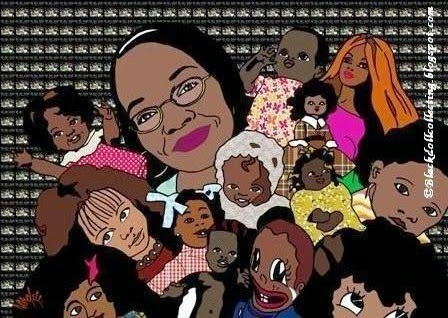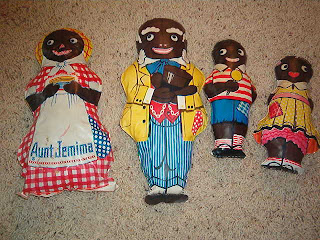1870s Black Cloth Couple
The above pair of dolls was given to me in 2005 by Elizabeth S. Darrah, having been made by her great grandmother, Frances "Fanny" Skinner Henry, who was born in 1849. According to Ms. Darrah, "Members of the Skinner Henry family were active abolistionists." The male has looped yarn hair. Both have button eyes, noses made of rectangular pieces of silk fabric, embroidered mouths, and silk used for their cloth exteriors. The male's clothing is all original. The female wears newer clothing (circa 1950s) over her original flannel undergarment.
Along with the multitude of handmade black dolls, manufactured dolls were also made during the 19th Century. These include dolls printed on cloth that were later handsewn in homes.
Aunt Jemima Doll Family, 1949, photograph courtesy of eBay seller, terryfromin
"Piccaninny"* Boy, Spring Mills Co. Child, and "Piccaninny" Girl
Handmade 30-in Mammy Vacuum Cleaner Cover, photograph courtesy of Margaret Mitchell
No longer piccaninnies, in today's doll market, black cloth dolls have evolved from mammies to elegant goddesses and divas. Modern cloth dolls will be discussed in a subsequent post.
*Pickaninny (also picaninny, piccaninny or pickinniny) is a racial slur that refers to a depiction of dark-skinned children of African descent. It is a racist and derogatory caricature, whose meaning and usage grew to fruition in the antebellum American south, where the enslavement of Black people was legal. [https://en.wikipedia.org/wiki/Pickaninny] It is a term that should have never been used to describe a person, let alone an innocent child.
dbg



I just love cloth dolls and soft sculpture. These are the type of dolls that I enjoy sewing.
ReplyDeleteI am fond of today's cloth dolls as well as the picaninnies. Although the mammies, golliwogs and picaninnies could be viewed today as unsavory, I think that they are still a part of the history of black dolls that cannot be overlooked. I posted a few pics of some mammies & picaninnies that I saw displayed in New Orleans. I didn't purchase any this time because I have a few of them already in my collection.
Thanks for sharing! :0)
Hi Hugs,
ReplyDeleteYes, the early black cloth dolls are definitely part of black-doll history and cannot be overlooked. While I do not actively collect derogatory pieces, I do own samples of a few unsavory dolls with the exception of golliwogs. There is no place for a golliwog in my collection. The other pieces I own are reminders of what was. They allow me to embrace the present with expectation for greater things in the future.
dbg
I have one or two gollies. I view them as educational pieces of what "once was". I also know that they do not appeal to everyone. I am saving my collection to pass on to my grandchildren and nieces. I also have Black Americana items that truly irritate me, but I still bought them for the education of the younger generation. I put them away in a drawer and when I come across them, I cringe.
ReplyDeleteI have a black doll that looks a lot like the vacuum cleaner cover above only it's small, no clothing, and sits on a rectangle. It's only the head, arms, and torso. I do not feel it's appropriate for me to keep it (I found it in a relative's house after she passed away) but I don't think it should be thrown out, either. Should it be donated to an African American museum? Or maybe it should be thrown out since it is a derogatory depiction? I'm not sure what to do with it and would appreciate any advice.
ReplyDeleteHi Kim - No, no, no, no, no! Please do not throw out or otherwise discard the black doll/appliance cover. While many dolls, other playthings, household items, advertisements, etc. from the past did not depict AAs in a positive light, they are part of American history. Our history cannot and should not be erased. These relics serve as a reminder of how things were and how far we have progressed (even though we still have a way to go with reference to seeing and treating everyone as our equal). By all means, if there is an African American museum in your area, donate the piece to them. I am sure they will be happy to receive it.
ReplyDeletedbg
Thank you for the advice; I will donate it. :)
ReplyDeleteEarly Black American Cloth Dolls Enthusiast said:
ReplyDeleteI just received a Black American Cloth Doll-type. It is a doll on top and a broom handle underneath. anyone know about where I can find info on her?
Thanks Ms. Elle
Early Black American Cloth Dolls Enthusiast said:
ReplyDeleteI just received a Black American Cloth Doll-type. It is a doll on top and a broom handle underneath. anyone know about where I can find info on her?
Thanks Ms. Elle
I just came across a rag doll hold it one way and it's a black rag doll turn it up side down and push the dress down and you have a white doll. Anybody know anything about when and stories. I was told it was my great grandmothers so that would be back in the late 1800's.
ReplyDeleteYour doll is a topsy-turvy. Read more about the history of the dolls here or do a Google search for "topsy turvy" for additional sources of information.
Deletedbg
I have a black vintage rack doll that is faceless. I haven't seen anything exactly like it online. Wondering if anybody could give you more information on this particular doll
ReplyDelete